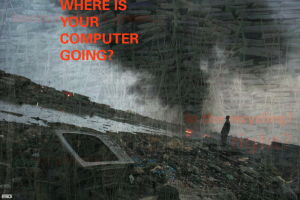Carnegie Mellon Design Students Focus on the Environment
At the end of Carnegie Mellon University’s fall semester, the School of Design held a one-day exhibition for the senior class, showcasing projects from all the areas of design that make up the school’s renowned curriculum. As an alumni and design professional, I found numerous points of interest in the range of work, the way it was presented, the topics addressed through design, and the evolution of CMU’s design program. The latter is indicative of the design field’s ever-changing character and multi-dimensional nature—design constantly redefines itself to encompass new processes, technologies, and ideas.
The show was nicely designed to fit in the place it was held, a large empty retail space in Pittsburgh’s new East End complex, Bakery Square. For displaying their work, students built their own platforms and tables out of corrugated cardboard and used thin wire lines to hang posters, amounting to a superbly minimalist industrial décor. I appreciated that these details were addressed almost as much as I appreciated the variety of work—industrial design projects like wood furniture, independent study projects like a screen-printed fashion line or building a custom wood-encased portable turntable, video projects, games, and more. But the thing that I felt inclined to investigate was a course called Speak Lab, in which all the students somehow communicated messages related to environmental issues.
Because of evolveEA’s commitment to sustainability and our focus on design, I decided to sit down with the course instructors for some background and invite a few students to present their projects to evolveEA staff one day during lunch. Speak Lab was one of three intensive rotations that design seniors took last semester as part of the program’s new lab format. The focus for this lab was on storytelling, while in Play Lab students explored concepts through quick prototyping, and in Wonder Lab they developed research methods.
Peter Scupelli and Stacie Rohrbach, the instructors for Speak Lab, explained how they came up with the environmental topics that became the subject matter for this lab’s projects: “we collected imagery of unbelievable phenomena, like exploding melons, or water catching on fire—of nature gone awry,” said Stacie. She explained that from this starting point they had a collection of footage that needed to be explained through storytelling. For example, the burning water was a clip taken from the documentary Gasland, which teaches viewers about hydraulic fracturing (“fracking”). Peter and Stacie shared examples like these with the students and challenged them to tell their own stories about nine environmental-themed topics from which they could choose.
Students Nick Abele, Zari Salimnejad, and Erica Stine joined us at our office so we could take a closer look at their Speak Lab projects.

Nick collected data on pollutants from the EPA and envisions a database of Pittsburgh neighborhoods and their air quality.

Zari teaches viewers about the environmental effects of the global dairy and meat industry’s overpopulation of cows through a museum exhibition.
And Erica deals with the problem of E-Waste through an attractive booklet that presents facts and data in a powerful, layered, image-driven format.
Our time spent with the students was inspiring. We see the real-world application of design thinking through our own work, but tomorrow’s professional designers have a lot to teach us when it comes to keeping the process fresh. Collaborating with the School of Design has been a treat and we hope to continue this moving forward.


